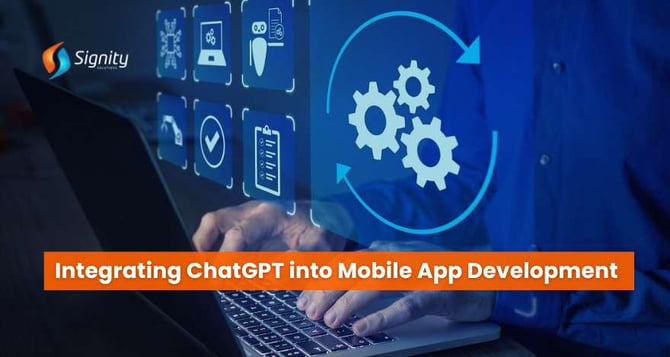Integrating ChatGPT into Mobile App Development
Explore how integrating ChatGPT into mobile apps transforms user interactions, providing personalized experiences and real-time assistance. Unlock the potential of AI to revolutionize your app's engagement and functionality.

Introduction
ChatGPT, powered by OpenAI, is a cutting-edge natural language processing model that enables developers to integrate conversational AI capabilities into their applications. In this guide, we'll explore how to integrate ChatGPT seamlessly into mobile app development projects.
Getting Started with ChatGPT
Before diving into integration, it's essential to understand the fundamentals of ChatGPT. ChatGPT leverages deep learning techniques to generate human-like text responses based on the input it receives. Developers can interact with ChatGPT through simple API calls, making it easy to incorporate into various applications, including mobile apps.
Boost User Engagement with ChatGPT Integration
Experience a 50% increase in user engagement by integrating ChatGPT. Elevate your app's capabilities today!
Steps to Integrate ChatGPT into Your Mobile App
-
Sign Up for OpenAI API: To gain access to ChatGPT, sign up for the OpenAI API. You'll receive an API key that you can use to authenticate requests to the ChatGPT service.
-
Install SDKs or Use REST API: Depending on your mobile app development platform, you can either use SDKs provided by OpenAI for languages like Python, JavaScript, or Java or directly interact with the REST API.
-
Design Conversational Flows: Determine how you want ChatGPT to interact with users within your mobile app. Design conversational flows and scenarios to provide a seamless user experience.
-
Integrate ChatGPT into Your App: Use the chosen SDK or make HTTP requests to the ChatGPT API endpoints within your mobile app codebase. Handle user inputs and pass them to ChatGPT for processing, then display the generated responses to the user.
Enhancing User Experience with ChatGPT
Integrating ChatGPT into your mobile app can enhance the user experience by providing personalized and engaging interactions. Whether it's providing recommendations, answering questions, or assisting with tasks, ChatGPT adds a human-like touch to your application.
Setting Up Authentication and Authorization
If opting for API integration, developers must set up authentication and authorization to access OpenAI's API securely. This typically involves obtaining an API key from OpenAI, which is used to authenticate requests and track usage. Developers should follow best practices for securely storing and handling API keys within their mobile apps to prevent unauthorized access.
Implementing API Requests
Once authentication is set up, developers can begin implementing API requests to interact with ChatGPT. Depending on the specific use case and requirements of the mobile app, developers can make requests to ChatGPT's endpoint with user prompts as input parameters. It's essential to handle API responses appropriately, including error handling and parsing the generated text for display to the user.
Related Read: Building and Deploying a Web API Powered by ChatGPT
Optimizing for Mobile Performance
Mobile app developers must optimize ChatGPT integration for performance and efficiency, considering factors such as network latency, device resources, and user experience.
Techniques such as caching responses, batching requests, and optimizing network calls can help minimize latency and improve responsiveness. Additionally, developers should consider the computational resources required to run ChatGPT on mobile devices and optimize for resource usage accordingly.
Ensuring Privacy and Data Security
Privacy and data security are paramount when integrating AI capabilities into mobile apps, particularly when handling sensitive user data or conversations.
Developers should adhere to industry best practices and regulations for data privacy, including encryption, data anonymization, and secure transmission protocols. It's essential to communicate clearly with users about how their data is collected, used, and protected within the app.
Testing and Iterating
As with any integration, thorough testing is crucial to ensure the seamless functioning of ChatGPT within the mobile app. Developers should conduct extensive testing across different devices, operating systems, and network conditions to identify and address any issues or performance bottlenecks.
Additionally, soliciting feedback from users and iterating on the integration based on their experiences can help optimize the user experience and drive continuous improvement.
How Our Company Can Help
As a leading generative AI development company, we specialize in integrating cutting-edge AI technologies like ChatGPT into mobile applications. Our team of experienced ChatGPT developers is well-versed in leveraging AI to enhance user experiences and drive business growth.
Our Services Include:
-
Consultation and Strategy: We'll work closely with you to understand your mobile app requirements and develop a tailored strategy for integrating ChatGPT effectively.
-
Custom Development: Our team will handle the end-to-end development process, from designing conversational flows to seamlessly integrating ChatGPT into your mobile app.
-
Optimization and Maintenance: We provide ongoing support to ensure optimal performance and continuous improvement of ChatGPT integration within your mobile app.
Partner with Top AI Developers for Mobile Apps
Collaborate with our expert AI developers to unlock ChatGPT's full potential in your mobile app. Let's create something amazing!
Conclusion
Integrating ChatGPT into mobile app development offers a myriad of opportunities to enhance user engagement, provide personalized experiences, and enable natural language interactions.
By following the steps outlined above and leveraging the appropriate integration methods, developers can seamlessly incorporate ChatGPT's capabilities into their mobile apps.
Whether it's providing real-time assistance, facilitating conversations, or powering chatbots, ChatGPT integration opens up new possibilities for delivering intelligent and intuitive mobile experiences.


%201-1.webp)


.png?width=344&height=101&name=Mask%20group%20(5).png)
.jpg?width=1200&height=250&name=How%20to%20Build%20an%20App%20With%20ChatGPT%20(1).jpg)
.png?width=1200&height=250&name=Top%20Industries%20That%20Could%20Benefit%20from%20ChatGPT%20(1).png)
















